�
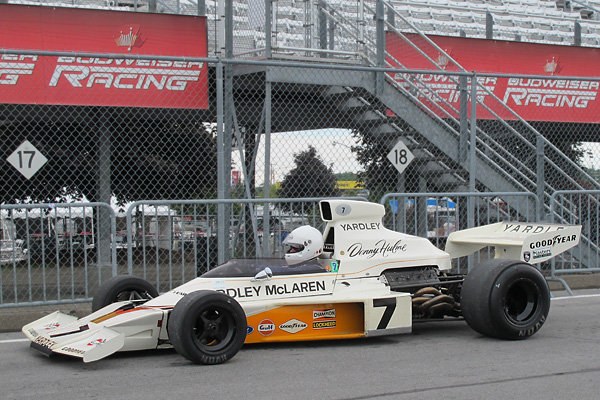
�
McLaren M23 Formula One Racecar (Serial# M23/1)
� ��
Owner: Phil Mauger
�
City: Christchurch, New Zealand
�
Model: 1973 McLaren M23
�
Engine: Ford Cosworth DFV V8 (3L)
�
Prepared by: John Crawford�
�
Denny Hulme's McLaren M23 Returns to Watkins Glen
��
McLaren's M23 model is among the most enduringly successful designs in Grand Prix racing history.�
The M23 was competitive at the top tier of Formula One racing over a remarkable five season�
career, spanning 1973 through 1977. The M23 delivered Formula One's Constructors Championship�
to McLaren in 1974. Emerson Fittipaldi and James Hunt drove M23s to Formula One Drivers�
Championships in 1974 and 1976 respectively.�
�
The very first M23 was completed late and pressed into service after just a couple�
days of testing. It had already missed the first two races of the 1973 season, but it would be�
driven by Denny Hulme for the whole balance of the year. That car, "M23/1", was quick right out�
of the box, achieving pole position at its first two races! At two other races, Hulme posted the�
quickest laps of any entrant. One of these was the inaugural Swedish Grand Prix, which�
Hulme won with an exceptionally strong finish. Hulme had been delayed at mid-race when�
flying sand jammed-up one of his throttle slides, but on his way to the pits it worked itself�
clear. After losing twenty seconds on the leaders, "the bear" rampaged forward. He finally�
stole the lead from home-crowd favorite Ronnie Peterson on lap 79 of 80.�
Hulme's teammate, Peter Revson, drove another M23 to two wins of his own in 1973.�
All this was against exceptionally tough competition, including defending champion Jackie Stewart�
in his Tyrrell plus Emerson Fittipaldi and Ronnie Peterson in Lotus 72 racecars.�
The 1973 Formula One season came to its end at Watkins Glen, where Denny Hulme scored a�
fourth place finish in the United States Grand Prix.�
�
Almost thirty-eight years later, in September 2011 McLaren M23/1 returned to Watkins Glen to�
race again. BritishRacecar.com was there with three cameras. Many others have written about�
the M23 model. We believe we're the first to document the McLaren M23's design and construction�
with over sixty large, close-up, color photos. �
�
�
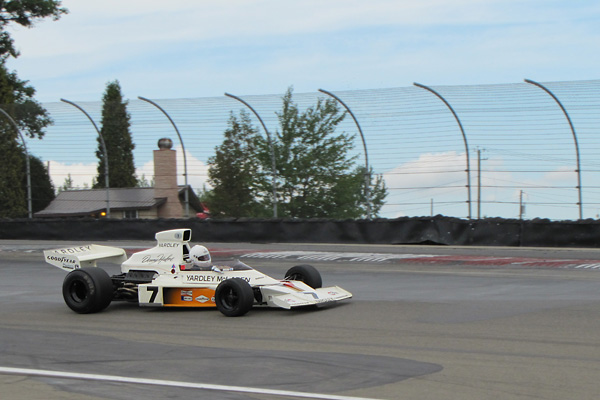
�
Denny Hulme's McLaren M23 returned to race at Watkins Glen in 2011
�
�
Please support the sponsoring companies who make www.BritishRaceCar.com possible, including:
� �
 �
�
�
�
About the McLaren M23's Place in History
��
The McLaren M23 was immediately preceded by a more curvaceous model known as the "M19".�
The M19 had been designed by Australian engineer Ralph Bellamy, who left McLaren and�
returned to his previous employer: Brabham. Frankly, it hadn't been a particularly�
successful design. It hadn't scored any race victories in its first year, and with it�
the McLaren team had only placed sixth in the 1971 Constructors Championship. 1972 was�
only a little better: one championship series race victory and third in Constructors points.�
Like many of its contemporaries the M19 was made obsolete by new Formula One safety�
regulations. It didn't have sufficient "deformable structure" protecting its fuel cells. �
�
Responsibility for McLaren's new M23 model was assigned to Gordon Coppuck who had�
previously designed McLaren's Can-Am and Indy cars. Coppuck had most recently�
designed the 1972 Indianapolis 500 winning McLaren M16. As one would expect, the�
pragmatically wedge-shaped M16 foreshadowed the M23's design much more than the�
elaborately bulbous M19. Achieving a low polar moment of inertia had been a design�
priority; it made the car more nimble. To this end the M16 had featured hip-mounted�
radiators. On the other hand, an inboard mounted fuel cell spaced apart the driver�
and engine. One feature of the M19 was carried over intact. The M19's rising-rate front�
suspension, once developed, had begun to work well. It facilitated a lower front ride�
height, which was a big aerodynamic advantage. Other than front suspension, the M23�
design was pretty much completely new.�
�
As mentioned already, new Formula One rules called for deformable structure to protect�
fuel cells from side impacts. Coppuck's interpretation of this rule led him to develop �
non-detachable side pods which channeled air into the dual side-mounted radiators.�
Interestingly, rather than place the radiators inside the side pods he instead�
bolted them onto the back. The side pods are an early example of "composite sandwich"�
construction: between an outer wall of aluminum and an inner wall of fiberglass,�
Coppuck specified a measured charge of aerosol spray foam and hardening catalyst.�
Inboard of the side pods, the spaces between inner and outer aluminum monocoque skins�
were similarly stiffened with two-pack foam.�
�
�
 �
�
�
�
�
Modern racers take for granted quick-release steering wheel hubs. The McLaren M23�
was one of the first racecars to come standard with this important feature. It was�
especially needed because the M23 has a very narrow cockpit and because since 1971�
Formula One rules had mandated that drivers must be able to be evacuated from the�
cockpit in less than five seconds. �
�
The McLaren works was located directly across a cul-de-sac from the Graviner fire extinguisher�
company. Graviner helped McLaren stay on top of fire safety developments, and McLaren�
helped Graviner become the preferred supplier throughout Formula One racing. McLaren M23/1�
is credited as the first Formula One car equipped with a medical air supply plumbed to the�
driver's helmet and configured to automatically turn on in the event of an accident.�
It ran with a Graviner life support system at Zolder on May 20, 1973. Graviner had access�
to and knowledge of the necessary components because they had long been used in high altitude�
aviation. Similar systems were mandated by Formula One rules starting in 1979.�
�
McLaren's M23 model is credited with twenty championship-qualifying Grand Prix victories. �
Development problems with its replacement, the McLaren M26, resulted in an extended phase-out�
for the M23. The McLaren works team entered M23s in eleven of 1977's seventeen races.�
Second tier teams entered McLaren M23s in fourteen of sixteen races of the 1978 season.�
Very few racecars have proved as adaptable to the changing technical requirements of their era. �
�
�
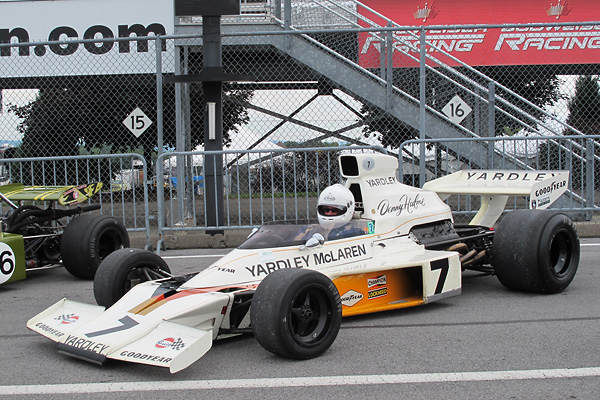
�
McLaren M23/1 had a two year racing career. In 1973 it was driven by 1967 Grand Prix World Champion
�
driver Denny Hulme. In 1974 the McLaren team provided Hulme a brand new racecar and M23/1 was
�
updated to M23B specification for driver Mike Hailwood. M23/1 displayed similar Yardley soap and
�
cosmetics company livery in both 1973 and 1974, but its racing number was updated from "7" to "33".
�
1973 Season - Denny Hulme (NZ) in McLaren M23/1
�| Date | Race Name | Venue | Results | Comments | |
| 3/3 | South African GP | Kyalami | Q1 F5 | Hulme leading until a punctured tire forced pit stop. | |
| 3/17 | Race of Champions | Brands Hatch | Q1 F2 | Hulme leading w/ 5 laps to go when clutch failed. | |
| 4/8 | BRDC Intl. Trophy | Silverstone | Q5 DNF | (engine failure) | |
| 4/29 | Spanish GP | Barcelona | Q2 F6 | ||
| 5/20 | Belgian GP | Zolder | Q2 F7 | ||
| 6/3 | Monaco GP | Monte Carlo | Q3 F6 | ||
| 6/17 | Swedish GP | Anderstorp | Q6 F1 | Hulme posted fastest lap of race, at 104.04mph. | |
| 7/1 | French GP | Paul Ricard | Q6 F8 | Hulme posted fastest lap of race, at 117.51mph. | |
| 7/14 | British GP | Silverstone | Q2 F3 | Teammate Revson: Q3 F1. (Scheckter: shunt!) | |
| 7/29 | Dutch GP | Zandvort | Q4 DNF | (engine failure) | |
| 8/5 | German GP | Nürburgring | Q8 F12 | ||
| 8/19 | Austrian GP | Österreichring | Q3 F8 | ||
| 9/9 | Italian GP | Monza | Q3 F15 | Teammate Peter Revson qualified 2nd, finished 3rd. | |
| 9/23 | Canadian GP | Mosport | Q7 F13 | Teammate Peter Revson qualified 2nd, finished 1st. | |
| 10/7 | United States GP | Watkins Glen | Q8 F4 | ||
| World Drivers Championship: 6th Place | |||||
1974 Season - Mike Hailwood (GB) in McLaren M23/1
�| Date | Race Name | Venue | Results | Comments | |
| 1-13 | Argentine GP | Buenos Aires | Q9 F4 | Teammate Hulme won. Teammate Fittipaldi debuted. | |
| 1-27 | Brazilian GP | Interlagos | Q7 F5 | Teammate Fittipaldi qualified fastest & won race. | |
| 3-17 | Race of Champions | Brands Hatch | Q7 F4 | ||
| 3-30 | South African GP | Kyalami | Q12 F3 | ||
| 5-26 | Monaco GP | Monte Carlo | Q10 DNF | (shunt) | |
| 7-7 | French GP | Dijon | Q6 F7 | ||
| 7-20 | British GP | Brands Hatch | Q11 DNF | (spun) Fittipaldi qualified 8th & finished 2nd. | |
| 8-4 | German GP | Nürburgring | N/A | (shunt in pre-race practice) | |
| World Drivers Championship: 10th Place (tied) | |||||
�
note: Mike Hailwood crashed M23/1 heavily in practice for the German Grand Prix, ending the car's�
Grand Prix career. Hailwood then qualified and raced spare chassis "M23B/7". In this second car,�
Hailwood crashed again and suffered a serious leg injury. The McLaren team rebuilt M23/1 to a�
suitable standard for demonstration use and presented it to Denny Hulme. The remains of M23B/7�
were scrapped. �
�
McLaren M23 Production History
��
How many McLaren M23s were built? The serial number sequence starts at one and runs through�
fourteen, skipping number "13" for luck. (There are two other anomalies in the sequence. When�
faced with a need to rush a newly-built tenth car through Swiss customs, it proved expeditious�
to stamp number "8" onto its chassis plate. This small deception was rectified by amending�
the number 8 with a "dash 2". The original eighth M23 had been wrecked, but it was later repaired�
and issued chassis plate number "10".)�
�
There are five basic M23 design iterations, which correspond generally to five years of�
construction. Distinctions between the five specifications are blurry for various reasons,�
not the least of which is that cars were updated throughout their respective careers.�
Cars were in fact modified for the unique requirements of almost every race entered.�
Formula One's habit of implementing rules changes mid-season also complicates issues.�
�
Four M23s were built in 1973, followed by four more in 1974. The 1974 cars feature a longer�
wheelbase to suit a rule change pertaining to reducing rear wing overhang distance. Other�
changes for 1974 included modifications to the front suspension, parallel links in lieu of�
inverted A-arms for the rear suspension's lower connections, and wider rear track.�
�
In 1975, McLaren built two more M23s, which featured revised front and rear suspensions.�
Other changes for 1975 included a different airbox, addition of a driver adjustable front�
anti-roll bar, a shorter nose, and altered side pods.�
�
No new cars were built for 1976, but some of the existing cars were updated to a revised�
specification which included a new low-profile airbox to suit the latest rule change.�
Other changes for 1976 included addition of a driver adjustable rear anti-roll bar,�
substitution of an air starter for the previous electric starter, substitution of a six�
speed gearbox for the previous five speed gearbox, and installation of a different cockpit�
surround (which utilized Kevlar instead of glass fiber for a substantial weight reduction!)�
�
In 1977, McLaren built three final M23 racecars to a fifth level of specification, which�
included redesigned front uprights to suit new Goodyear tires.�
�
�
McLaren briefly flirted with offering a modified version of the M23 for Formula 5000. The�
essential difference would be with use of production-based 5.0L Chevrolet V8 engines in lieu�
of race-bred 3.0L Cosworth DFV V8 engines. Exactly one car of this type was built. For�
various reasons, the debut of McLaren M25/1 was considerably delayed. It only participated�
in two Formula 5000 races near the end of the 1976 season. M25/1 showed remarkable potential:�
Bob Evans drove it to a second place finish at Brands Hatch! Then, his engine suffered a�
broken piston midway through next race of the series. Formula 5000 ceased to exist in England�
after just three more races, but in an interesting turn of events M25/1 was rebuilt with a�
Cosworth DFV and was raced in nine "British Formula One" series races during 1977 and 1978.�
M25/1 has since been rebuilt to F5000 specifications for vintage racing. �
�
Features and Specifications
�| Engine: | �Ford Cosworth DFV V8 engine number 138, as delivered new to McLaren Racing in April 1973,�
rebuilt by Steve Weeber's Performance Engine Centre Ltd. in Christchurch, New Zealand.�
(2993cc. 3.373" bore x 2.555" stroke. 11.0:1 static compression ratio. Rated 465bhp @ 10,500rpm.)�
New cylinder heads sourced from the Cosworth plant in Torrance California.�
Lucas mechanical fuel injection.�
Lucas OPUS (Oscillating Pick-Up System) electronic ignition system.�
Bosch ignition coil.�
Champion G56R spark plugs.�
Dry sump lubrication system.�
| �
| Cooling: | �dual radiators.�
Dual 25-row oil coolers. | �
| Exhaust: | �Simpson Race Exhausts custom fabricated stainless steel four-into-one headers. | �
| Transaxle: | �Hewland FG400 five speed, rebuilt by BPA Engineering Ltd.�
Girling master cylinder. | �
| Chassis: | �101" wheelbase, 65" front track, 62.5" rear track. | �
| Front Susp.: | �wide based lower wishbones with twin-plane triangulated upper control arms.�
McLaren proprietary magnesium uprights.�
Pull-rod actuated rockers.�
Vertical, inboard mounted aluminum-bodied double adjustable KONI model 8212 coilover shock absorbers.�
Proprietary magnesium uprights with live stub axles.�
Anti-roll bar, operated by inboard-mounted linkage. | �
| Rear Susp.: | �reversed lower wishbones, adjustable top links, and dual trailing links.�
McLaren proprietary magnesium uprights.�
Aluminum-bodied double adjustable KONI model 8212 coilover shock absorbers.�
Custom coil springs designed to become progressively coil-bound under load.�
Tubular adjustable (5-position) anti-sway bar. | �
| Brakes: | �(master) dual Girling master cylinders with integral reservoirs. Bias bar. � (front) Lockheed four piston calipers with 10.5" vented rotors (outboard-mounted), � (rear) Lockheed four piston calipers with 10.5" vented rotors (inboard-mounted). | �
| Wheels/Tires: | �McLaren magnesium racing wheels (13x11 front, 13x16-18 rear.)�
Avon racing tires (10.0/20.0/13 front and 15.0/26.0/13 rear.) | �
| Electrical: | �Enersys Powersafe SBS sealed battery.�
Ark Racing starter motor. | �
| Instruments: | �(left to right)�
Smiths dual fuel pressure (0-160psi) and water temperature (30-120C) gauge,�
Smiths Chronometric tachometer (0-12500rpm) with tattletale, and�
Smiths dual oil pressure (0-160psi) and oil temperature (30-120C) gauge. | �
| Fuel System: | �custom fuel cell (including rubber bladder and safety foam.)�
Kinsler cable-driven high pressure fuel pump.�
Kinsler fuel filter.�
Electric in-tank high pressure fuel pump. | �
| Safety Eqmt: | �Willans six-point cam-lock safety harness.�
Quick release steering wheel hub.�
Graviner centralized fire suppression system. | �
| Weight: | �~1268# (34/66 front to rear). | �
Please support the sponsoring companies who make www.BritishRaceCar.com possible, including:
� �
 �
�
�
�
Engine Installation
��
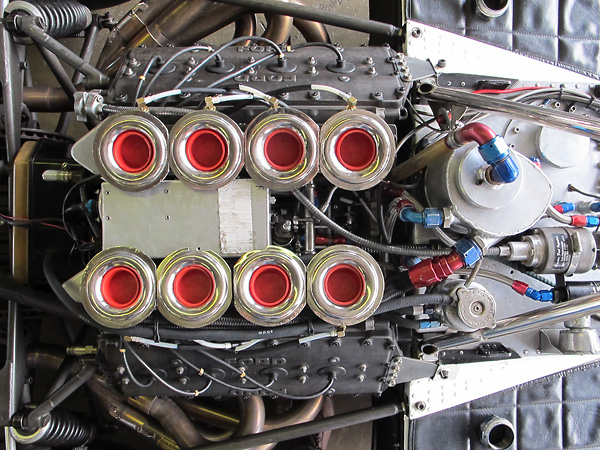
�
Fifteen of eighteen teams contesting the 1973 Grand Prix championship chose Cosworth's DFV
�
("Double Four Valve") V8 engines. In 1973 trim, these engines were probably producing about
�
460-465bhp. That's about 20-25bhp less than the Ferrari flat twelve, but more than BRM's V12.
�
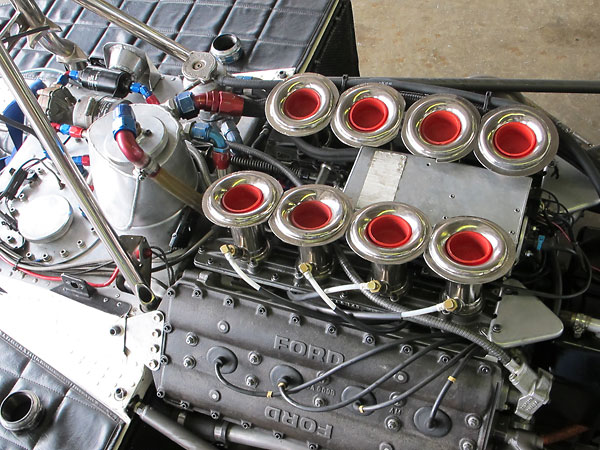
�
The McLaren M23's fuel cell was located between the driver and the engine, instead of inside
�
pontoons on either side of the monocoque tub as had been McLaren's previous practice on F1
�
cars. The new location was reckoned safer and provided less variation in weight distribution as
�
fuel was consumed. Formula One fuel tank standards had changed rapidly, with rubber bladders
�
first mandated for the 1970 season and addition of safety foam mandated for the 1972 season.
�
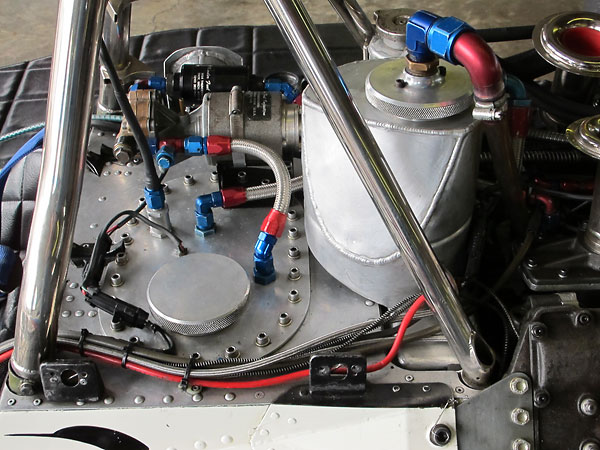
�
At left: fuel cap. Mid-race refueling wasn't permitted in Formula One races during the M23's era.
�
At right: engine oil reservoir. Cosworth installation and operation instructions advised:
�
"Oil tanks should allow for approximate consumption of 6 pints during a G.P."
�
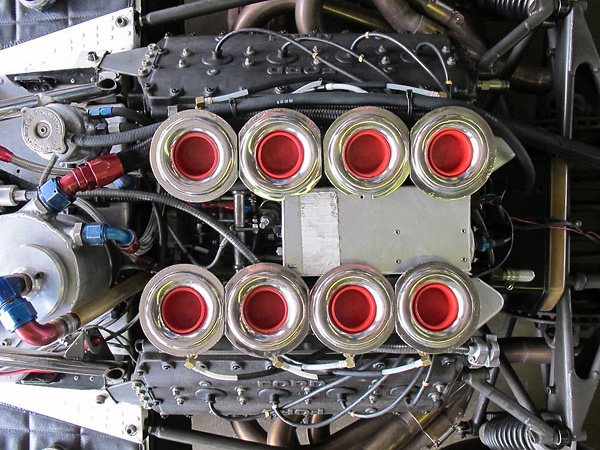
�
The intake stacks feature a full radius at the top to smooth entering airflow. Outboard of their radiused
�
section, they have a small flange where the airbox will seal to them. The engine draws its air supply
�
from a large plenum that's pressurized at racing speeds. More information about that appears below.
�
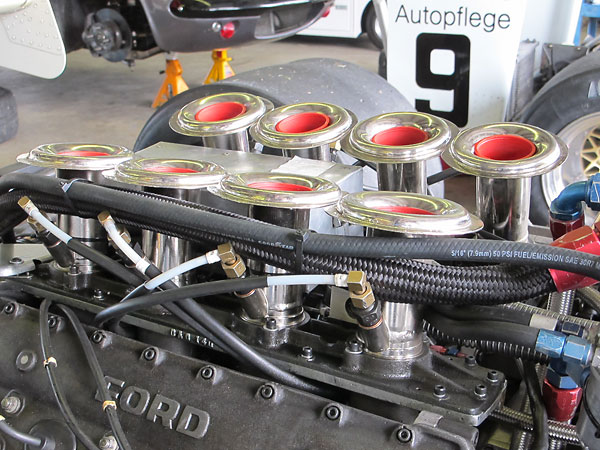
�
Lucas fuel injection, with one fuel injector per cylinder positioned upstream of a sliding throttle.
�
The function of Lucas' mechanical/timed nozzles is atomization only (i.e. not metering).
�
Earlier systems used "constant flow" nozzles, which actually metered fuel delivery as
�
a function of pressure drop across an orifice on the side of the nozzle.
�
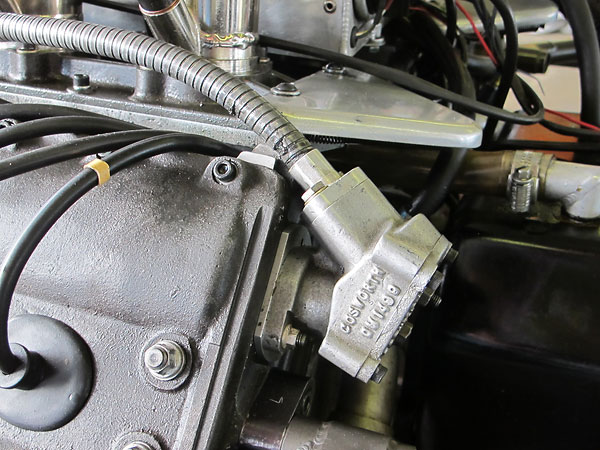
�
A high pressure mechanical fuel pump is driven via cable from one of the four camshafts.
�
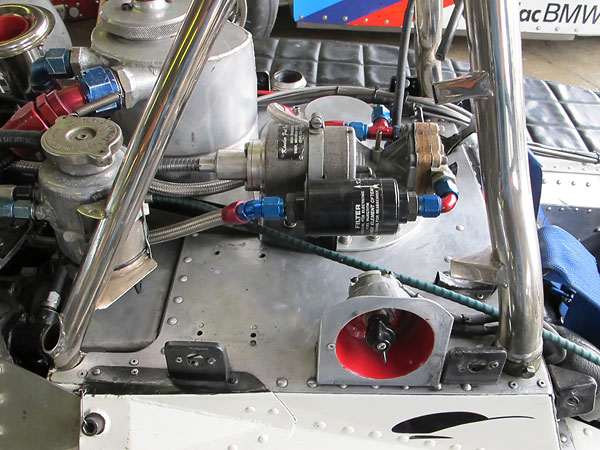
�
Center: Kinsler high pressure mechanical fuel pump. A high pressure electric pump is
�
located in series with this one, but it's hidden inside the fuel cell. The electric pump is
�
only needed for starting the engine. After that, it's turned off.
�
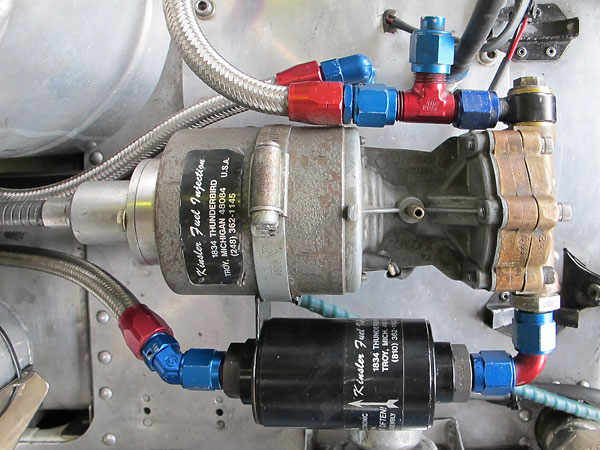
�
Labels read: "Kinsler Fuel Injection, 1834 Thunderbird, Troy, Michigan 48084 U.S.A., (248) 362-1145"
�
At bottom: Kinsler fuel filter.
�
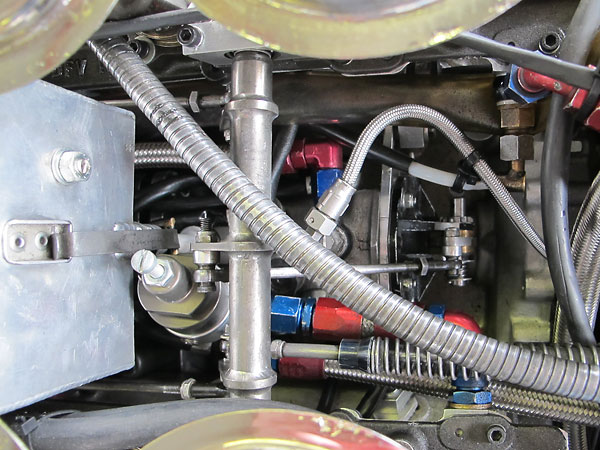
�
The Lucas Mk1 mechanical fuel injection metering unit is gear driven from off the crankshaft.
�
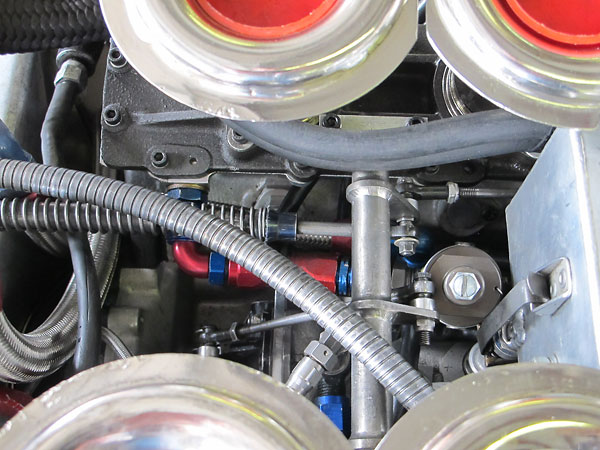
�
Throttle cable comes in from the left. A fuel pressure regulator can be seen at right.
�
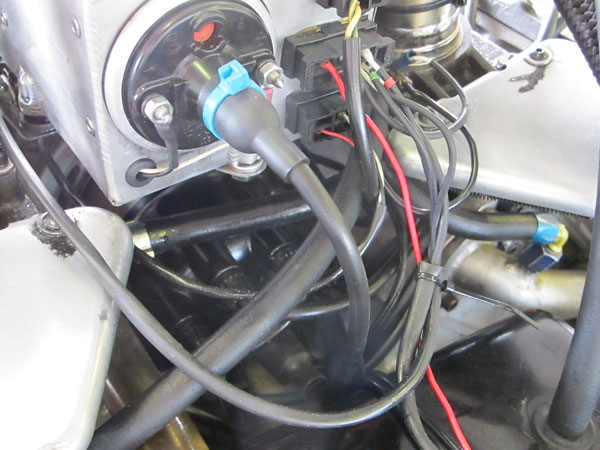
�
The DFV engine uses a Lucas OPUS ("Oscillating Pick-Up System") electronic ignition with a built-in
�
rev-limiter set at 10,500 rpm. Ignition timing is fixed at approximately 35° BTDC, triggered by
�
a variable reluctor sensor and a 40-tooth wheel on the front of the crankshaft. A conventional
�
distributor mounted in the engine's valley merely directs sparks to the respective cylinders.
�
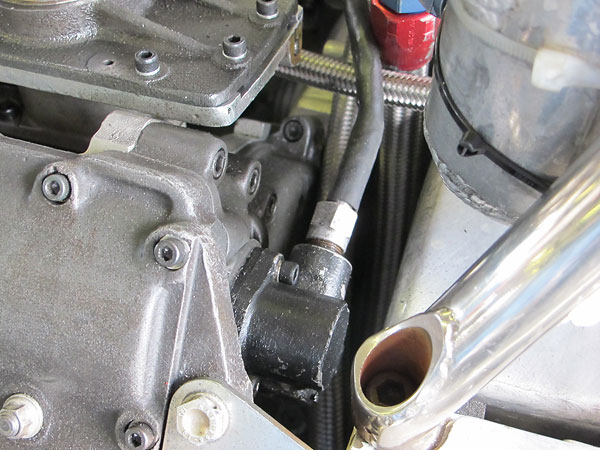
�
The Smiths tachometer is cable-driven off the front end of one of the camshafts.
�
Interestingly, Cosworth literature warned: "The engine must not be allowed to idle
�
under 2000 rpm at any time or else excessive cam and tappet wear may result."
�
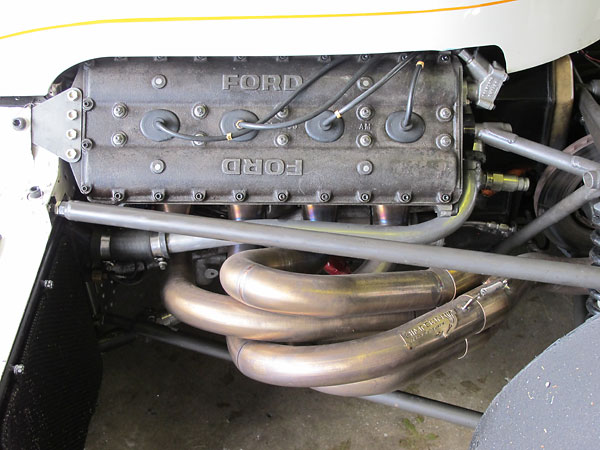
�
Pause to think about how many fasteners hold the magnesium valve covers to the
�
aluminum cylinder heads. No matter how you count, it's a lot of fasteners! Cosworth
�
promotional materials mentioned that their DFV engines were comprised of 3550
�
discrete parts, and that most of the parts required some amount of hand finishing.
�
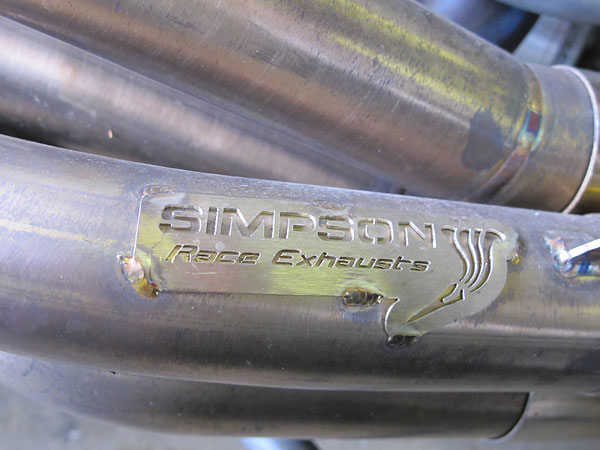
�
Simpson Race Exhausts custom fabricated stainless steel four-into-one headers.
�
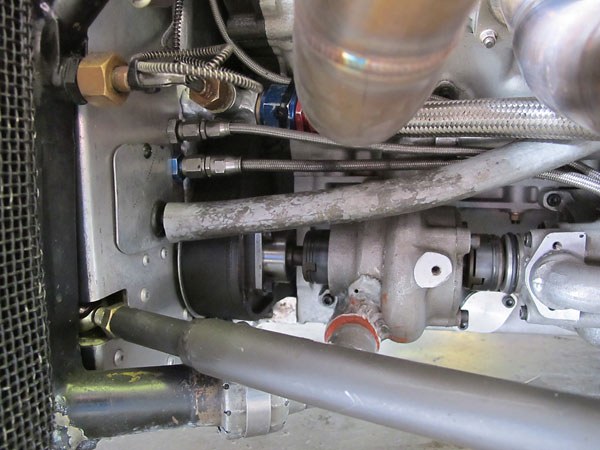
�
Two water pumps and two oil pumps... all belt-driven at one half of engine speed. This photo shows
�
one of two centrifugal water pumps. (The other water pump is on the opposite side of the engine.)
�
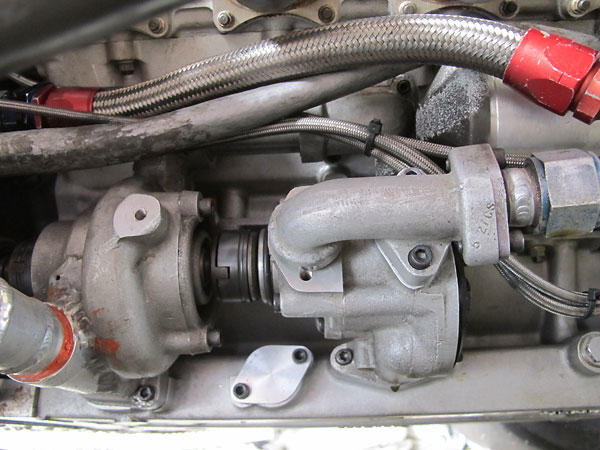
�
Behind and driven off of the left side water pump, the single-rotor high-pressure oil pump
�
should produce 80-90 psi at normal running speeds.
�
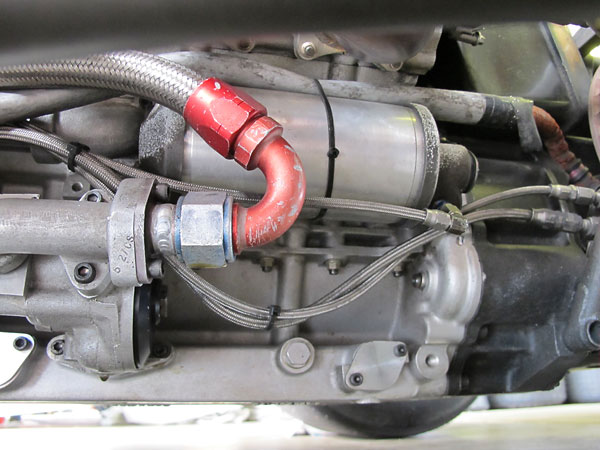
�
Canister oil filter (accepts Cosworth paper element oil filter part# PP0404).
�
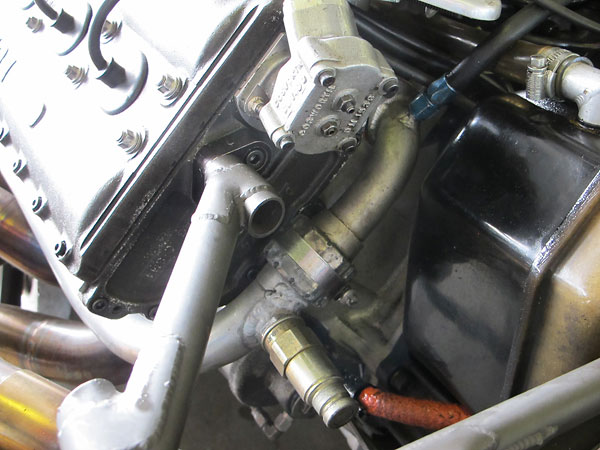
�
Twin water pumps route water into the sides of the engine block. The water flows upwards to the
�
cylinder heads through three passages around each cylinder (two by the exhaust ports, one on the
�
intake side). Water exits the cylinder heads through flanges at the rear. Thermostats are mounted
�
externally. Water flows around the engine to the radiator through hard tubing.
�
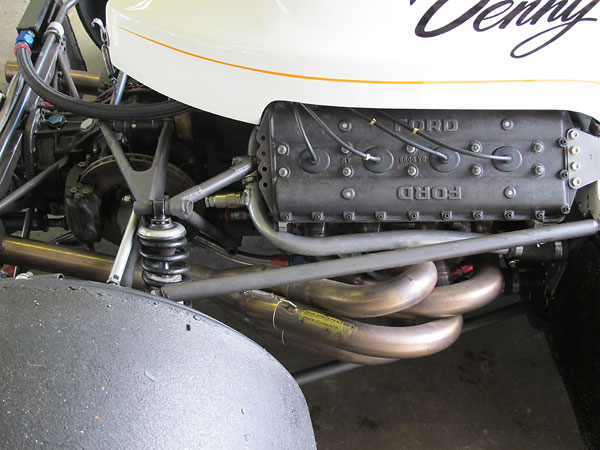
�
Cosworth recommended ordinary Autolite PG403 or Champion G56R 10mm motorcycle spark plugs.
�
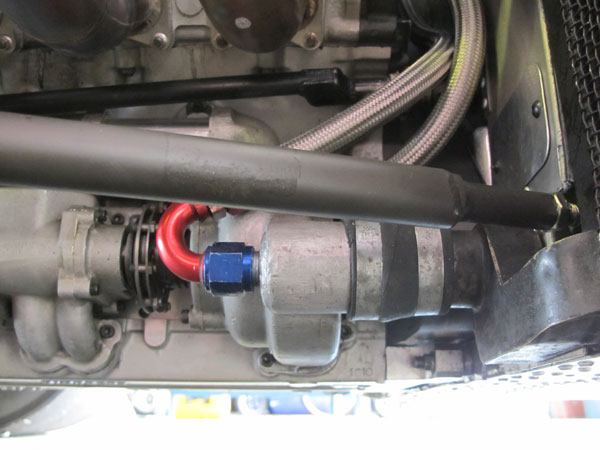
�
The second of two centrifugal water pumps.
�
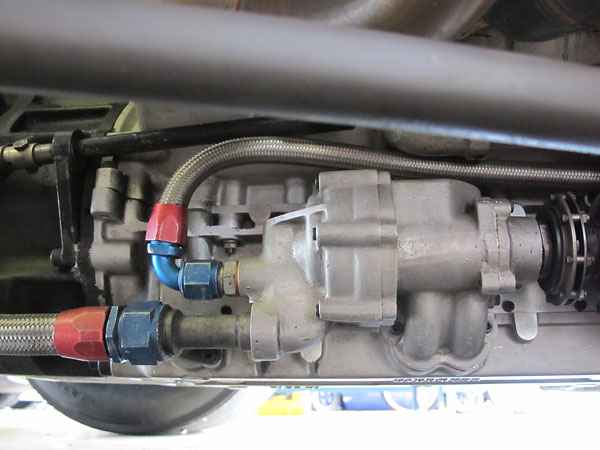
�
Scavenge oil pump. Beyond it, the dry sump oil system's cast aluminum oil pan which is an important
�
structurally stressed component of the engine (hence the chassis!) The oil pan features cast-in water
�
and oil passages, plus three integral main bearing caps (for main bearings 1, 3, and 5). The oil pan is
�
retained by 18 studs around its perimeter, plus two studs on each main bearing bulkhead.
�
(Main caps 1 and 4 are retained by 4 studs each.)
�
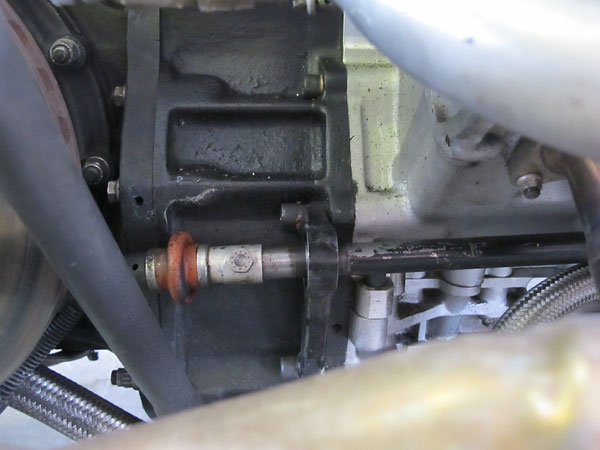
�
Apex universal joint on the gear shifter linkage. Beyond it, the bellhousing which connects the
�
Hewland FG400 transaxle to the engine and also houses the clutch assembly and flywheel.
�
When McLaren needed to meet a 1974 rule change regarding rear wing overhang, they
�
responded by developing a longer bellhousing. (The distance between wing and engine
�
stayed about the same, but the rear wheels were relocated several inches rearward.)
�
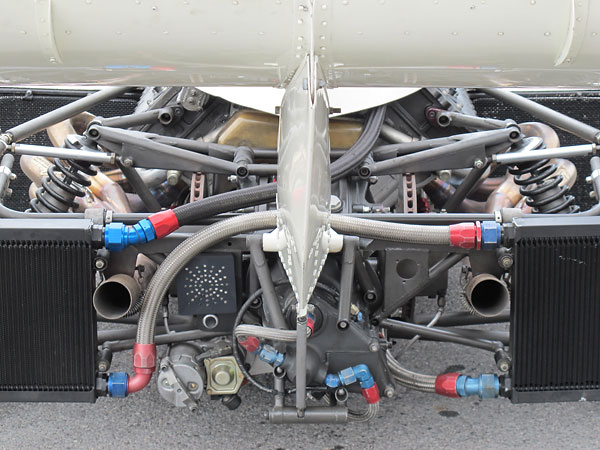
�
M23/1 was originally built with its oil coolers mounted immediately behind the radiators, but during
�
practice for its first race (the 1973 South African GP) cooling was determined to be inadequate and
�
they were moved to the back, where they remained. Left of center: the LED rain light is a modern
�
part. However, M23/1 would have had a (15W minimum) rain light from day one because they were
�
mandated by Formula One rules starting in 1972. You can see the original lamp bracket at right.
�
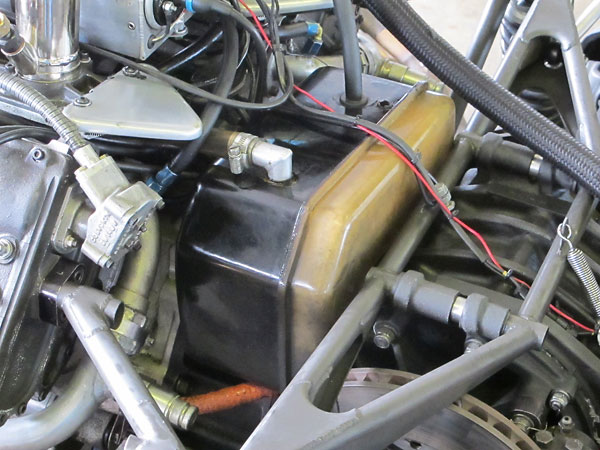
�
Breather/overflow tank.
�
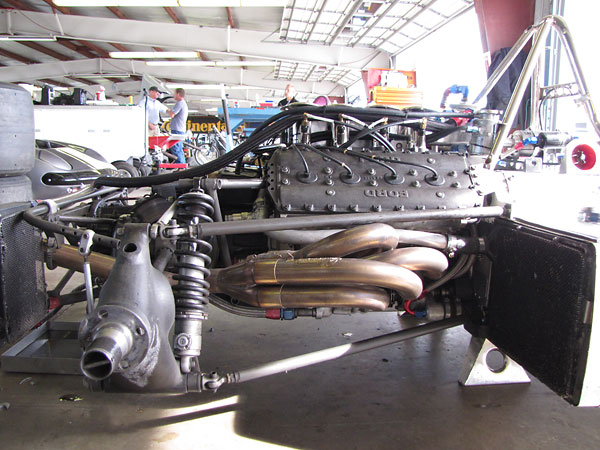
�
Steve Weeber's Performance Engine Centre Ltd. in Christchurch, New Zealand stripped down
�
and carefully inspected every part of the Cosworth engine. For the most part, it proved to be in
�
remarkably good condition, although a decision was made to store the original heads and to
�
source a new set from Cosworth. Cylinder liners were removed, fitted with new o-rings and
�
replaced. New piston rings and bearings were installed. So long as engine revs are kept
�
below 10,500rpm the engine should be good for 15-20 hours between rebuilds.
�
�
Front Suspension / Etc.
��
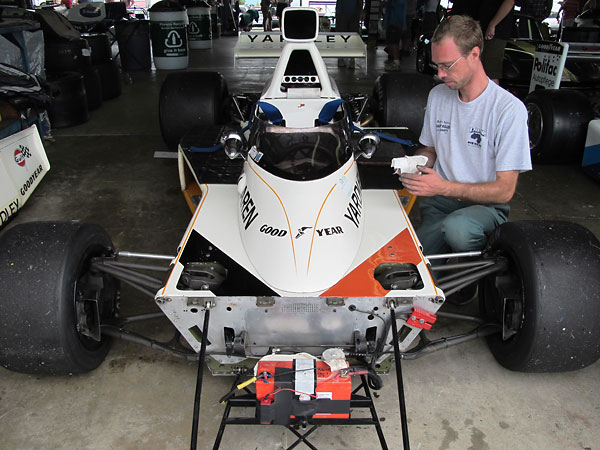
�
The McLaren M23's monocoque tub was fabricated from 16 gage aluminum. As had been McLaren
�
practice since Robin Herd's tenure (1965-1968), all panel joints were epoxy bonded. Rivets served
�
to clamp the panels together while the adhesive cured, but were largely redundant after that.
�
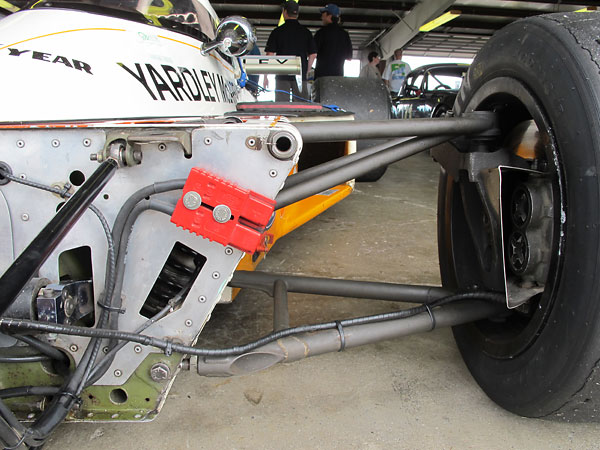
�
Where you see green or greenish structure behind the aluminum skin, that's steel. The M23 had an
�
elaborate steel front bulkhead assembly to carry suspension loads, plus steel brackets elsewhere.
�
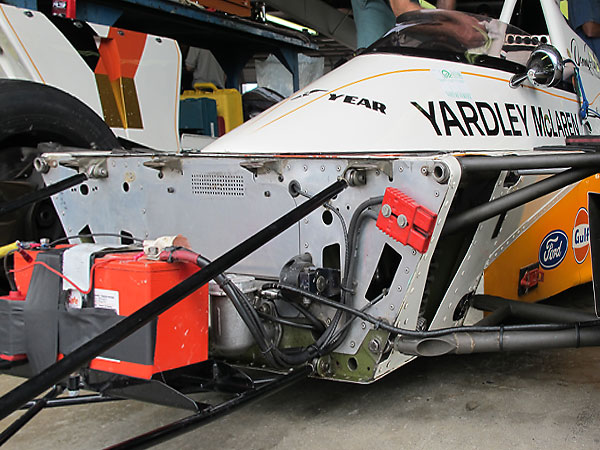
�
Since inboard-mounted suspension components competed for space.The pedal box is rather narrow.
�
Pedal adjustments are made from the front through a removable access panel.
�
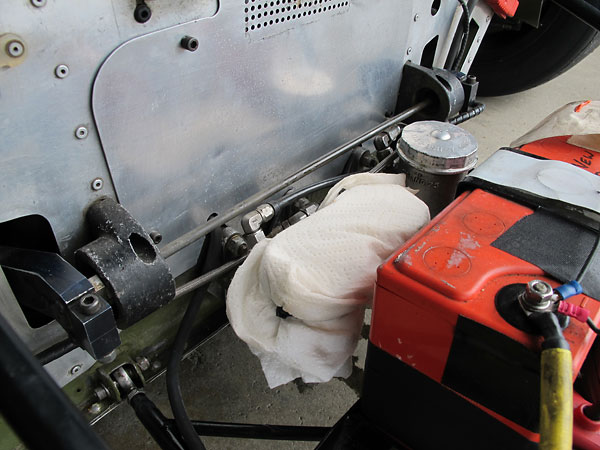
�
Girling master cylinders. Remarkably robust mounting for a surprisingly lightweight anti-roll bar.
�
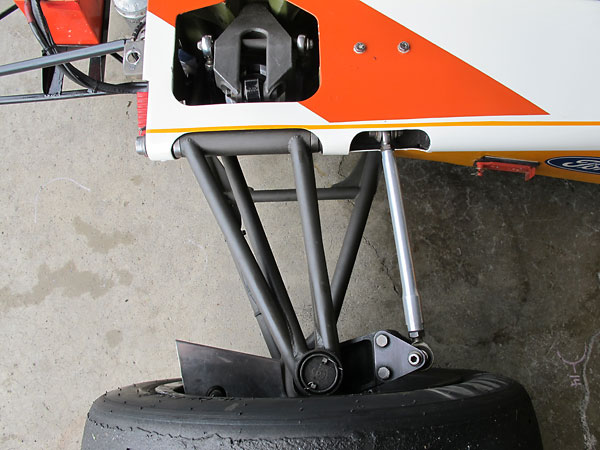
�
The McLaren M23 carried over the M19's rising rate front suspension. The premise of the design is simpler
�
than the execution: coil springs are mounted via bellcranks such that they compress further with increasing
�
wheel travel. Result: for a given energy absorbing capacity, bump travel is reduced and therefore ride
�
height can be significantly lowered. (Big aerodynamic advantage plus reduced camber change!)
�
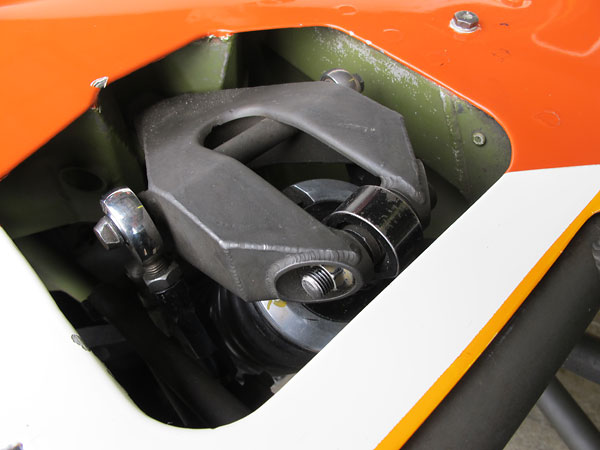
�
That the coilover shock absorbers and the anti-roll bar are tucked neatly away, entirely out
�
of the airstream, is another significant additional benefit of the McLaren M23's front suspension.
�
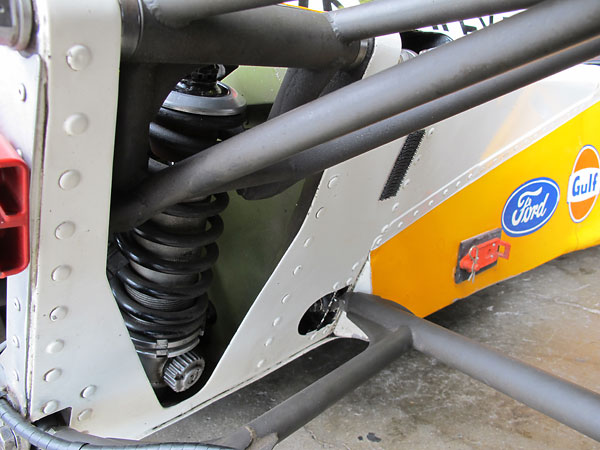
�
The McLaren M23 front suspension is remarkably easily serviceable. Notice that spring perch height and
�
shock absorber valve adjustments are within easy reach. On M23/1 the anti-roll bar isn't so conveniently
�
adjusted, but in 1975 McLaren introduced a cable-operated driver adjustable front anti-roll bar.
�
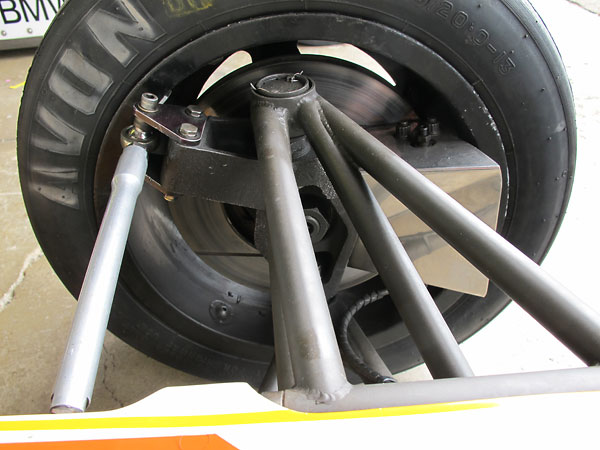
�
Starting in 1973 Formula One rules forbid chrome plating of steel suspension parts. The electroplating
�
process had been proven to substantially worsen a phenomena known as hydrogen embrittlement.
�
Hydrogen atoms are diffused throughout all steel alloys, and various manufacturing processes can
�
cause them to migrate, become concentrated, and build-up in in pressure to the point where cracks
�
start from within. Since the problem is worse with chrome plating than other finishing operations
�
(including nickel plating), Formula One rules singled chrome plating out.
�
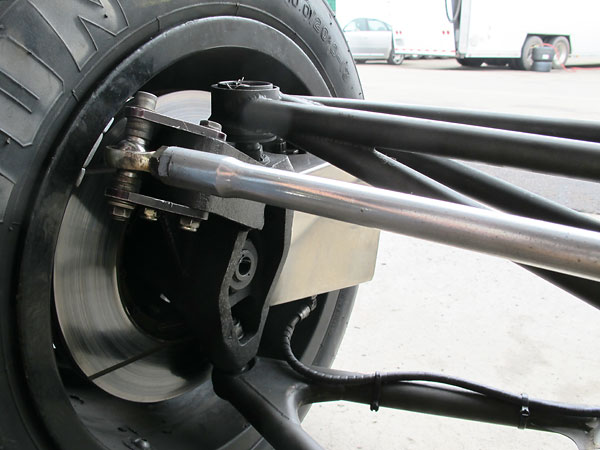
�
Magnesium front uprights. Note modestly sized brake ducts. Later M23s got larger ones.
�
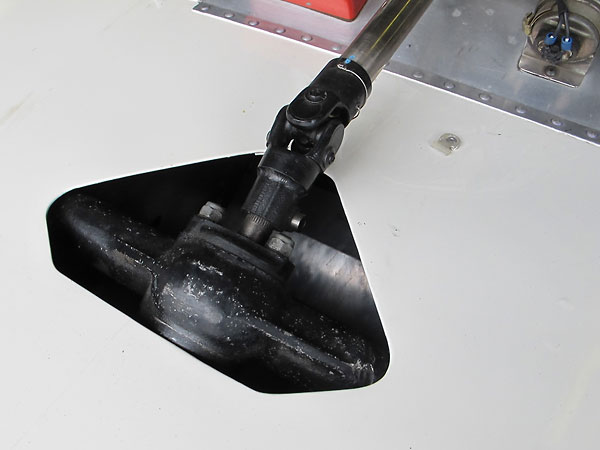
�
Bespoke magnesium steering rack.
�
�
Enjoying this article? www.BritishRaceCar.com is partially funded through generous support from readers like you!
�
To contribute to our operating budget, please click here and follow the instructions.
�
(Suggested contribution is twenty bucks per year. Feel free to give more!)�
Rear Suspension
��
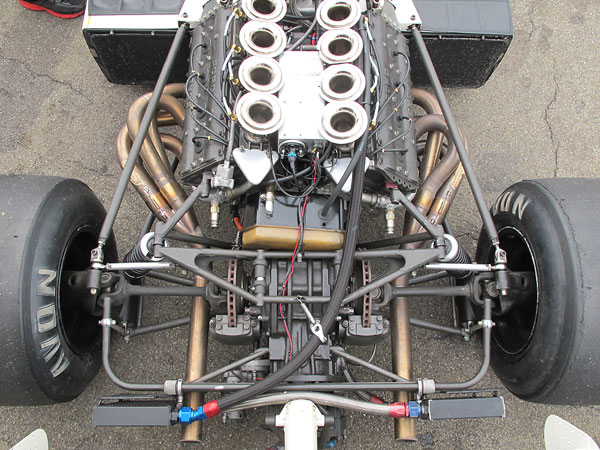
�
This view emphasizes a key characteristic of the Cosworth DFV engine and of all the racecar
�
designs that took advantage of its potential as an integral and structural part of the chassis.
�
Huge forces could be transferred through the DFV engine block, cylinder heads, and oil pan.
�
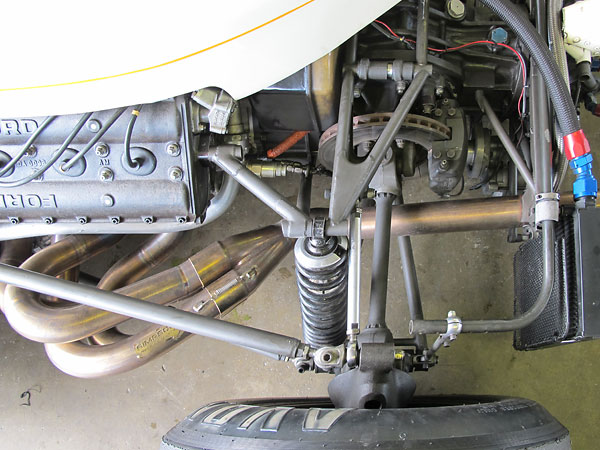
�
In 1973, Formula One teams spaced rear wings well back behind engines to maximize downforce.
�
(Two benefits: less turbulent airflow and increased leverage.) The rules changed for 1974, placing
�
a limit on how far rear wings could overhang rear wheels. Rather than simply move their wings
�
forward, McLaren cleverly moved wheels rearward. The main difference between an M23 and
�
an M23B is wheelbase, altered via a spacer at the bellhousing and by revised suspension links.
�
Reversed lower wishbones, as seen here, were replaced by parallel links from mid-1974 on.
�
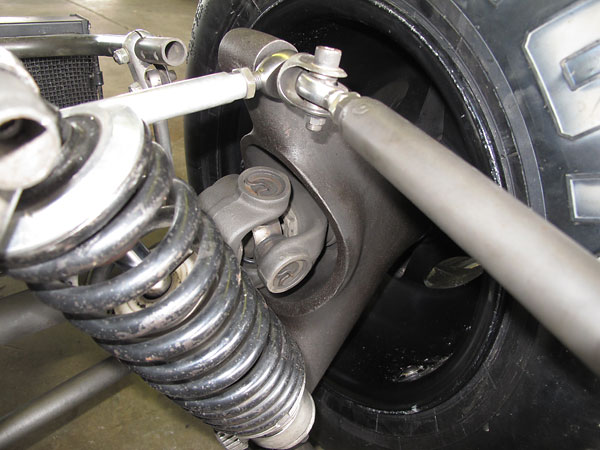
�
Suspension designers don't need bellcranks and actuating rods to produce a rising wheel rate.
�
To achieve a rising rate rear suspension on M23, McLaren (a) located upper spring mounts
�
well outboard, (b) specified denser coil spacing at the bottom of the springs, and
�
(c) used Silasto bump rubbers at the top of the rear shock absorbers.
�
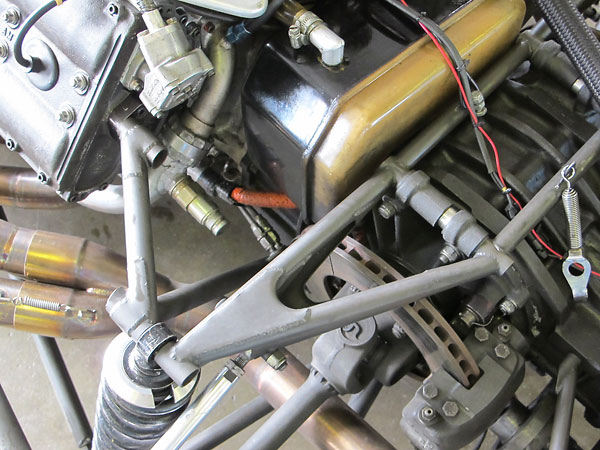
�
Laid down spring angles as commonly seen on outboard front suspensions tend to produce falling
�
rate suspensions. More upright spring mounting angles, as shown here, generate rising rates.
�
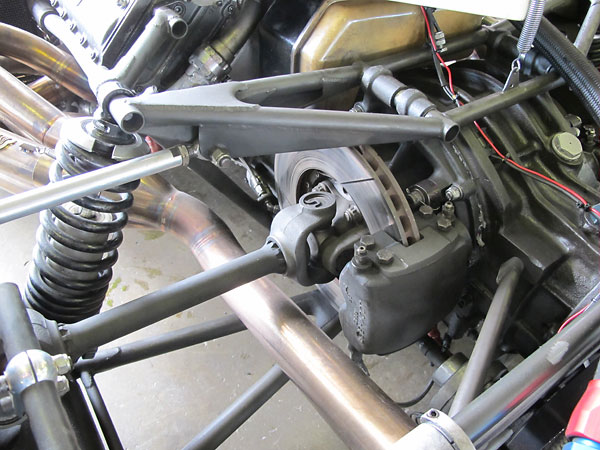
�
For the M23 rear suspension, Gordon Coppuck specified springs of variable coil pitch. As the
�
springs compress they progressively bind-up and wheel rate increases accordingly. The trouble
�
is one of quality; it's a big challenge to produce springs that increase rate as smoothly as desired.
�
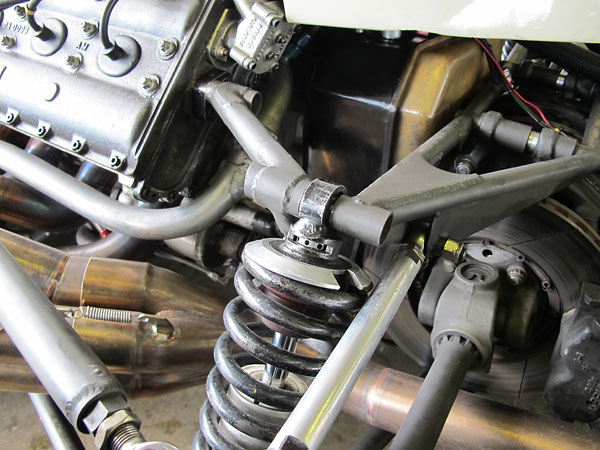
�
KONI developed and provided a range of special Silasto bump rubbers, and included a set with
�
these Model 8212 aluminum bodied, double adjustable, coilover shock absorbers. The specially
�
molded profile and the durometer of the bump rubbers were engineered to provide progressively,
�
increasing resistance through about 1.8 inches of compression.
�
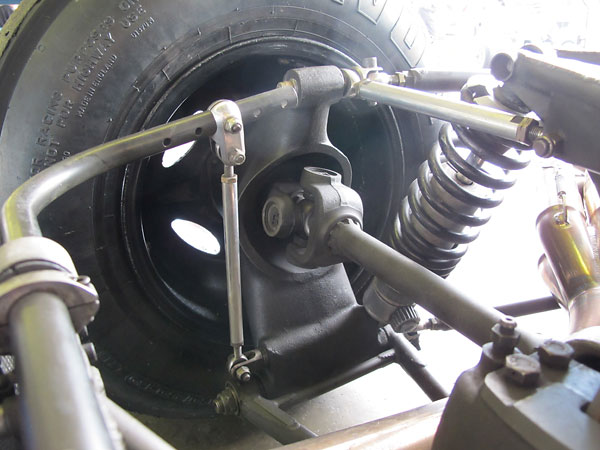
�
5-position adjustable anti-sway bar. Notice that its tubular construction reduces weight.
�
(The core of the bar adds little resistance to rotational deflection.)
�
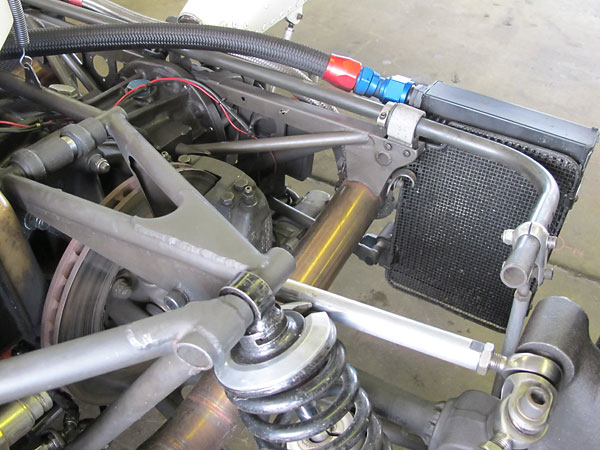
�
Oil coolers at the rear of a car are vulnerable. You can bet McLaren didn't like putting them there.
�
In fact, when M23/1 arrived in South Africa for its first race its oil coolers were mounted with its
�
radiators at the rear of the side pods. Too hot! Before the race, they were moved to the rear.
�
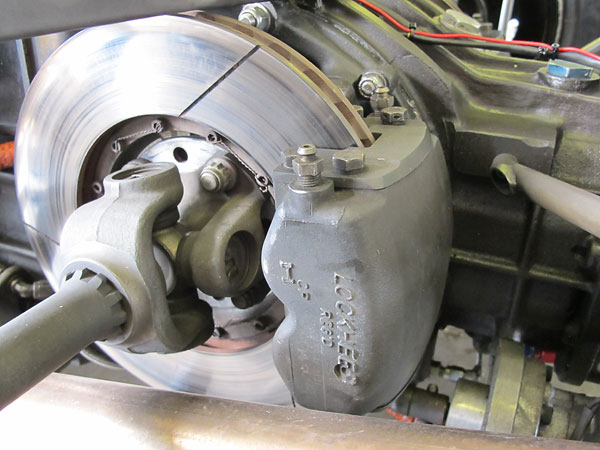
�
Lockheed four-piston brake caliper with 10.5" vented rotors, inboard-mounted.
�
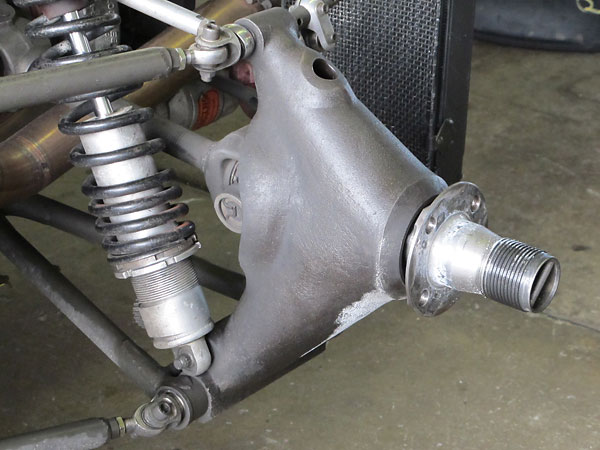
�
McLaren proprietary magnesium uprights.
�
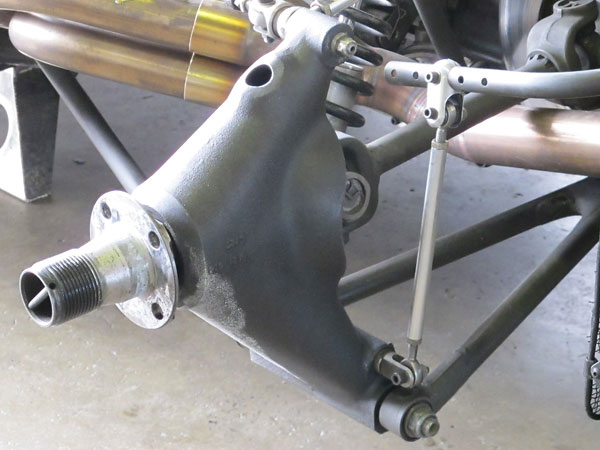
�
Lightweight double-splined titanium halfshafts were specified along with steel universal joint yokes.
�
Further weight savings was achieved by eliminating any conventional sort of sliding-spline joint.
�
Axle plunge was managed by allowing some floating at the hub bearings, inside the upright.
�
�
Interior
��
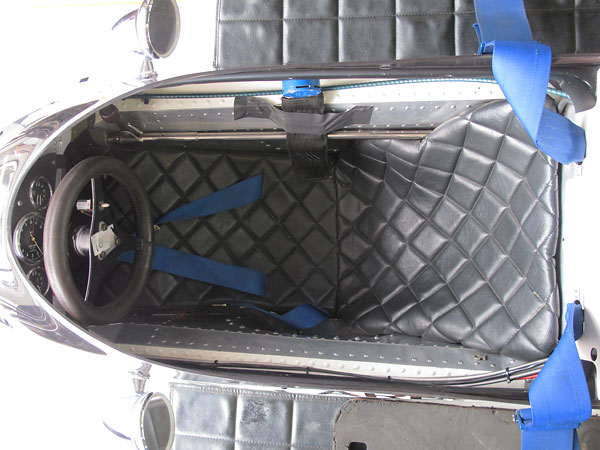
�
Six point safety harnesses have been required in Formula One racecars since the 1972 season.
�
The biggest difference between an M19 cockpit and an M23 cockpit is... temperature! Drivers were
�
very pleased that radiators and air cleaners had been moved rearward and that placement of fuel
�
tanks behind the drivers seat insulated them from heat radiating off the engine!
�
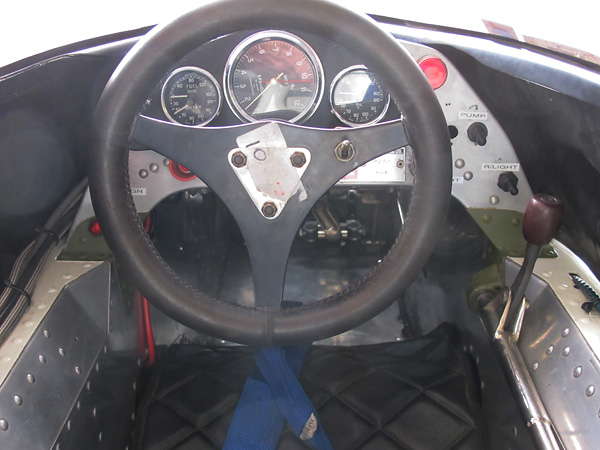
�
Smiths gauges (left to right): dual fuel pressure (0-160psi) and water temperature (30-120C) gauge,
�
chronometric tachometer (0-12500rpm) with tattletale, and dual oil pressure (0-160psi) and
�
oil temperature (30-120C) gauge.
�
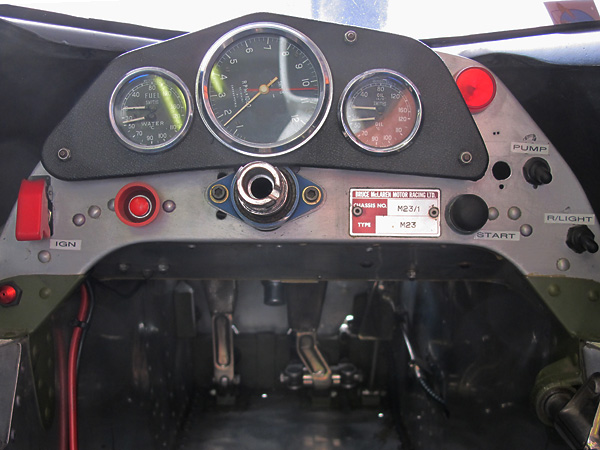
�
Chassis plate: Bruce McLaren Motor Racing Ltd., Chassis No. M23/1, Type M23.
�
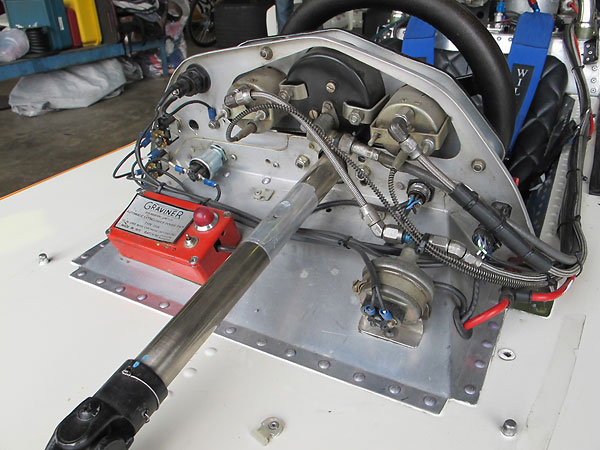
�
Graviner supplied fire suppression systems to Formula One teams through the 1970s. The company
�
also developed a life support system which featured breathable air ducted to the driver's helmet.
�
The Graviner life support system debuted in M23/1 at the 1973 Spanish GP. In this photo, the red
�
control box at left is labeled as follows: "Graviner Colnbrook Limited - Automatic Extinguisher
�
Power Pack Type 235A. To be used with cartridge unit 734A only. Made in 1972. Batch No. (?)."
�
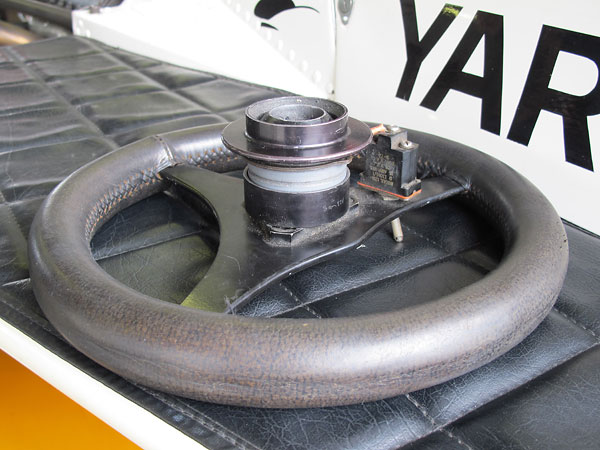
�
McLaren M23/1 was certainly one of the first, if not the first Grand Prix car to utilize a quick
�
release steering wheel hub. On one of the steering wheel spokes we see a Rotax Ltd. toggle switch.
�
It was wired as an emergency engine kill switch. Needs a guard! Emerson Fittipaldi accidentally
�
turned his McLaren M23's engine "off" during his debut race for the team at Buenos Aires, 1974.
�
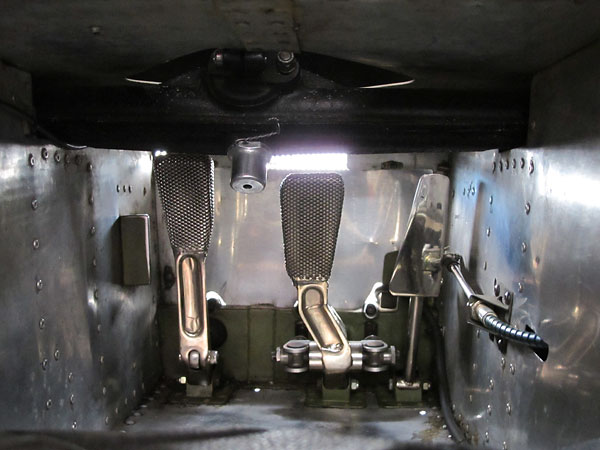
�
McLaren M23 footbox and pedals.
�
�
Exterior
��
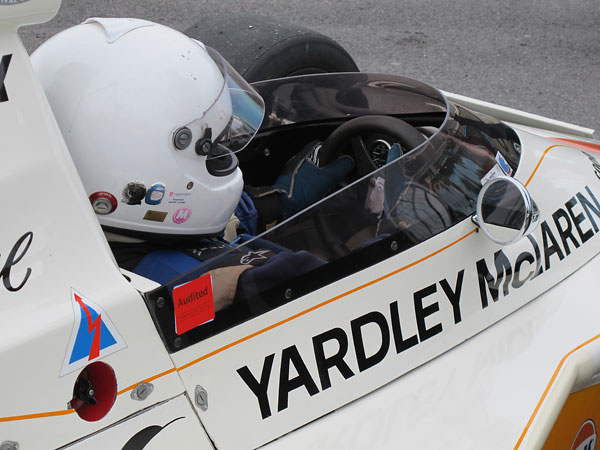
�
Frank Lyons came over from Ireland to demonstrate McLaren M23/1 at Lime Rock and Watkins Glen.
�
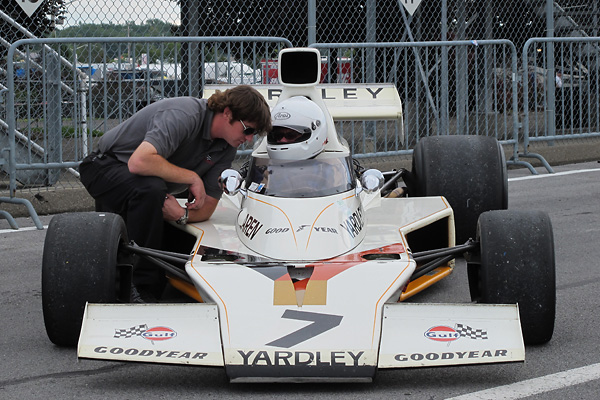
�
Chuck Golder, a full time mechanic for Lee Chapman racing, told us what he likes about the M23:
�
"Its simplicity! It's very easy to make adjustments. Everything is easy to get to. The suspension,
�
mostly carried over from the M19C, is a rising rate design. It has very low unsprung weight."
�
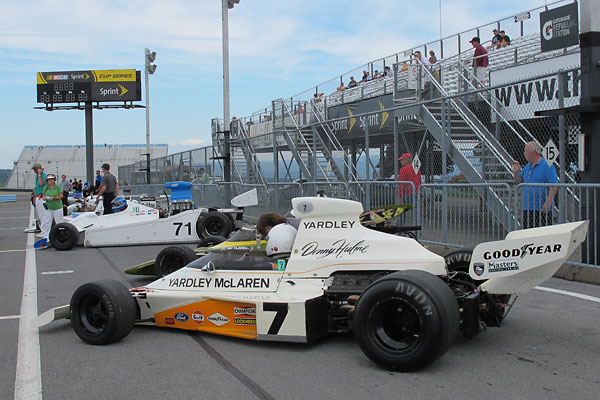
�
M23/1 has always worn "Yardley McLaren" livery. In 1973, the Yardley soap and cosmetic company was
�
McLaren's main sponsor. In 1974 the McLaren signed up Marlboro (cigarettes) and Texaco (oil/gasoline).
�
Through 1974, Denny Hulme and Emerson Fittipaldi drove cars with red and white Marlboro/Texaco livery
�
but Mike Hailwood took over M23/1 and raced under Yardley livery until his crash at the Nürburgring.
�
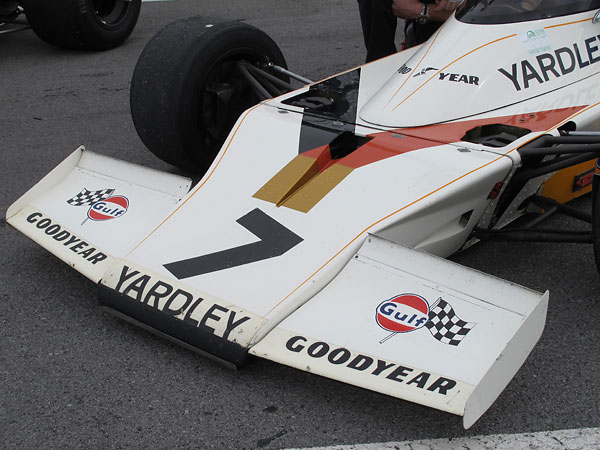
�
Before Denny Hulme retired at the end of the 1974 season, he arranged to purchase M23/1. Neither
�
its chassis nor its engine were suitable for front-line Formula One racing, but they'd been restored to
�
suit occasional demonstration runs at very high speed, and that's exactly how Hulme used the car.
�
After Denny died in 1992, the car was loaned to the auto museum in Te Puke New Zealand. The
�
museum closed in 2006, and Denny's wife Greeta sold M23/1 to Phil Mauger in June of that year.
�
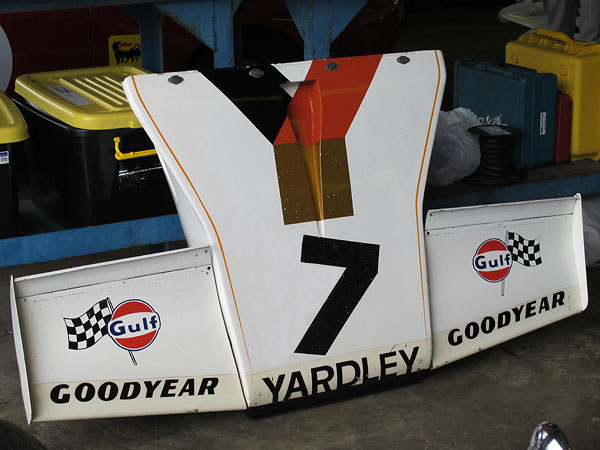
�
McLaren experimented with a narrower and shorter "winkle picker" nosecone in 1974, but otherwise
�
basic chisel-shaped nosecones served the M23 model well over its five year career. The design
�
however evolved quite a bit. It became shorter. The central driver-cooling duct disappeared in later
�
years. Two small side ducts for shock absorber cooling, remained. By 1976, McLaren switched from
�
fiberglass to Kevlar composite nosecones and cockpit surrounds for a substantial weight reduction.
�
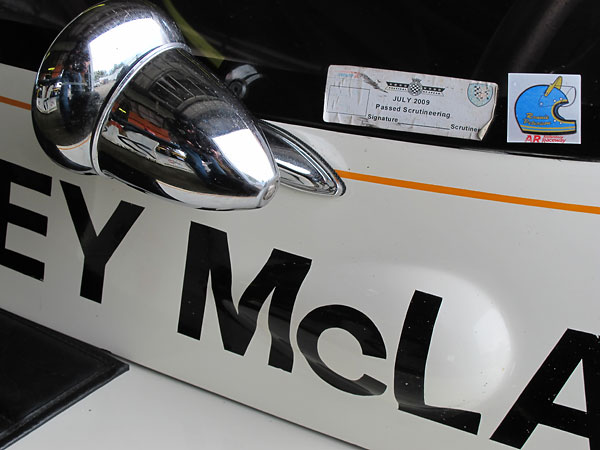
�
After acquiring M23/1, Phil Mauger commissioned John Crawford of Ruapuna New Zealand to
�
completely strip down the car and go over it with a fine tooth comb. Every last part was inspected
�
and the structural parts were all crack tested. Crawford decided to re-use quite a lot of the original
�
hardware because it was of superior quality and had very little mileage or wear since the McLaren
�
works had remanufactured the car. Paint was another matter: the car did need to be resprayed.
�
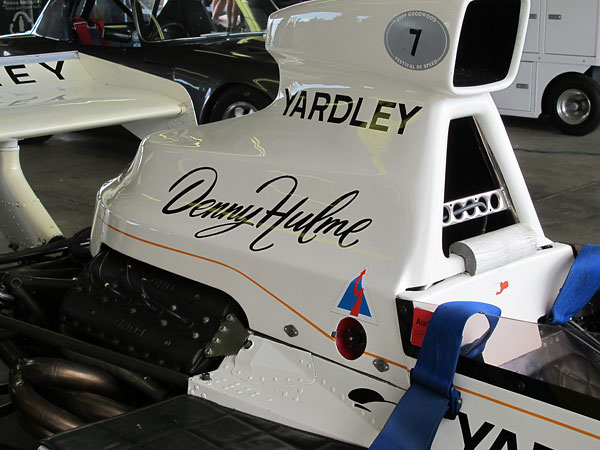
�
One of the most distinctive characteristics of early 1970s Grand Prix racecars, tall airboxes promised
�
increased air volume and a cooler/denser charge for the engine. Also, very importantly, airboxes
�
helped reduce the turbulence of airflow at the rear wing thereby improving aerodynamic efficiency.
�
Shown: the 1973-style M23 airbox. In 1974 McLaren phased in an even taller airbox with rectangular
�
opening. In 1976 tall airboxes were banned. After that, induction air was instead drawn from either
�
side of the roll hoop. (Note: the small decal reads: "2009 Goodwood Festival of Speed" and "7")
�
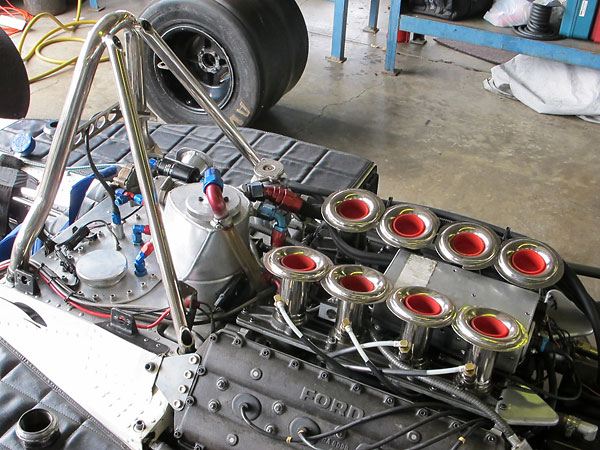
�
Rubber gaskets on the bottom of the airbox pressed down tightly against the velocity stacks.
�
Airbox design is a complex art. The internal shape must be contoured properly to ensure even
�
pressure and distribution of airflow between intake stacks, over the full range of vehicle speeds.
�
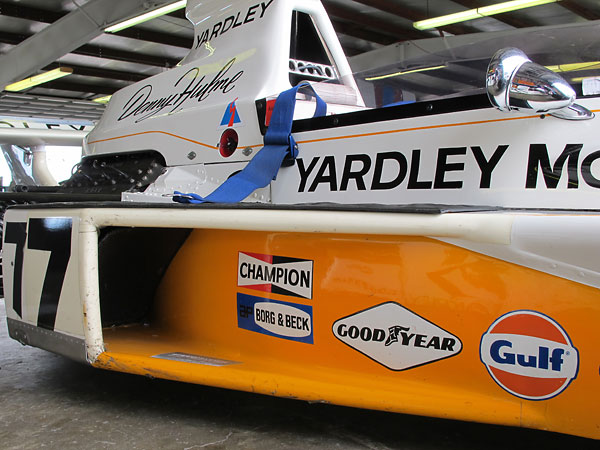
�
Exterior skins of the side pods were formed from aluminum. Inner walls were shaped in fiberglass.
�
Twin-pack aerosol foam was sprayed in to fill the (~3/4") gap. We understand two little tricks were
�
necessary to make this sort of composite sandwich construction work. Firstly, a shaped plug was
�
inserted to keep the fiberglass walls from distorting under the swelling force of expanding/hardening
�
foam. Secondly, drain holes were needed so excess foam could escape. The results were great,
�
but difficult to repair! - Sponsor decals: Champion, AP/Borg & Beck, GoodYear, and Gulf.
�
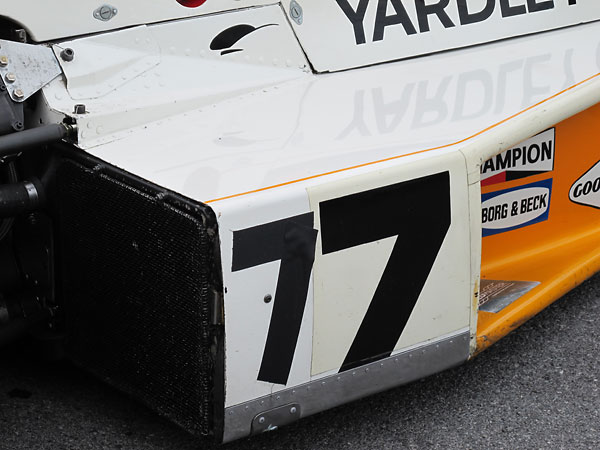
�
The side pods aren't detachable, so radiators had to be serviced from the rear. It wasn't until the
�
Dutch Grand Prix, midway through 1975, that McLaren installed extensions on the M23 sidepods.
�
One further technique to smooth airflow ahead of the rear wing!
�
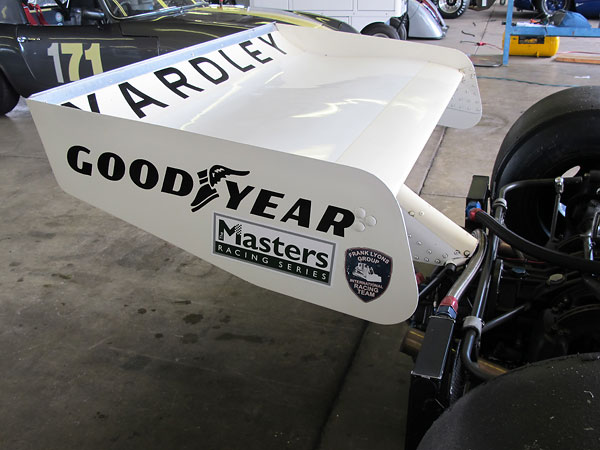
�
The GoodYear sticker is period correct. The Masters Racing Series is a modern U.K.-based club which
�
sanctions about a half dozen vintage GP events annually. Frank Lyons Group International Racing Team.
�
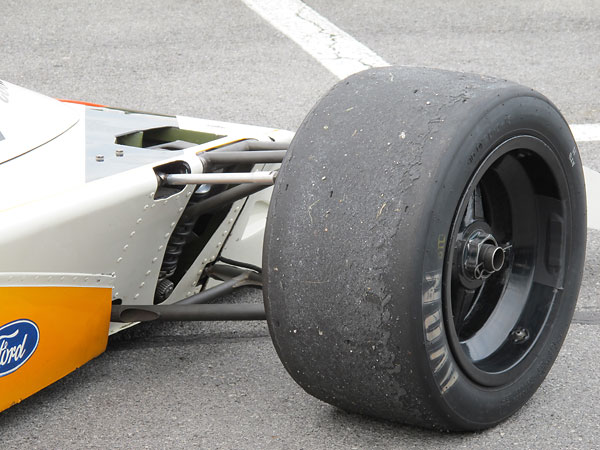
�
The McLaren team was Goodyear sponsored and ran Goodyear tires throughout M23/1's career.
�
In 1973, Formula One racing slicks ran softer compounds and lower air pressures than ever
�
before. Goodyears were judged best for qualifying. Firestones were best for wet races.
�
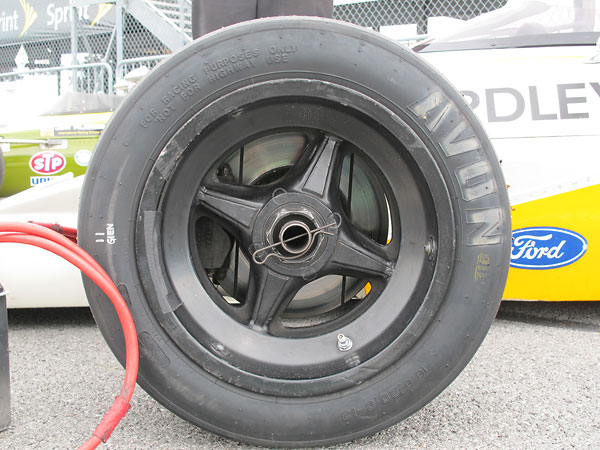
�
McLaren magnesium wheels.
�
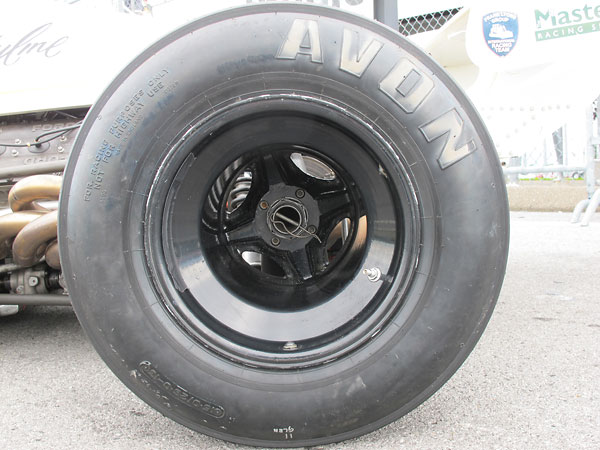
�
Avon racing tires (10.0/20.0/13 front and 15.0/26.0/13 rear).
�
| �
� 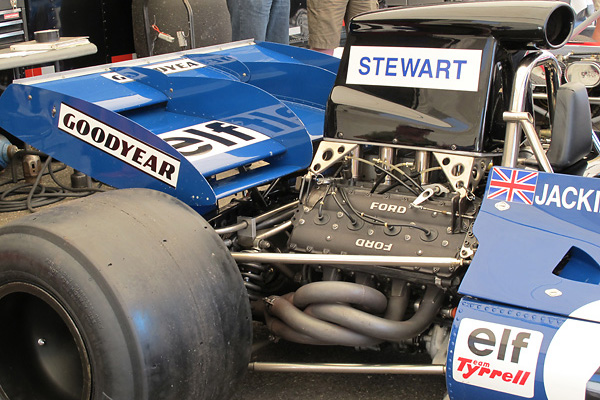 � (Tyrrell 004, as photographed by Curtis Jacobson for BritishRacecar.com) � Did you enjoy this article? We currently have eighty more in process, featuring about 6000 new photos. � It's research that slows things down. Please help by making a voluntary contribution to our library fund. � Your donation will help us complete and publish more articles, sooner! � � |
�
All McLaren photos are from September 2011 when M23/1 appeared at The US Vintage Grand Prix�
at Watkins Glen. Photos by Curtis Jacobson and Donnie Moyer for BritishRacecar.com. �
Copyright 2012. All rights reserved.
�
| If you liked this article, you'll probably also enjoy these: | �|||||
 | �
Kurt DelBene '64 BRP-BRM | �
 | �
John Dimmer '72 Tyrrell 004 | �
 | �
Scott Hughes '73 McLaren M8F | �
| You're invited to discuss anything you've seen here on The British Racecar Motorsports Forum! | �|||||
�
Notice: all the articles and almost all the photos on BritishRacecar.com are by Curtis Jacobson.
�
(Photos that aren't by Curtis are explicitly credited.) Reproduction without prior written permission is prohibited.
�
Contact us to purchase images or reproduction permission. Higher resolution images are optionally available.
�

 �
�